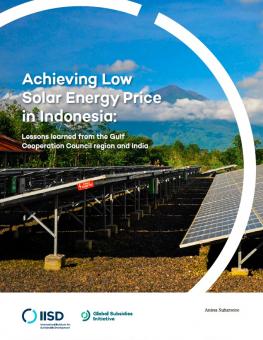
Achieving Low Solar Energy Price in Indonesia: Lessons learned from the Gulf Cooperation Council region and India
While solar energy has exploded in India and the Gulf Cooperation Council region, it has lagged significantly in Indonesia. This report examines why this has been the case and what Indonesia can do to catch up to others in growing the renewable energy sector in the country.
Key Messages
- India and the Gulf Cooperation Council region have seen significant expansion in solar energy prices, while Indonesia has lagged in the growth of solar despite aggressive policy targets.
- Key differences include land acquisition policies, policy enabling conditions, and a stable environment that have spurred investment, as well as lower perceived risk in investment in these two regions compared to Indonesia.
- Studying the best practices in these two regions could offer strategies for more renewables in Indonesia and assist in meeting the country's renewable energy targets for 2025.
Indonesia could take several lessons from the Gulf Cooperation Council (GCC) countries and India in terms of the development of renewable energy and how to achieve low electricity prices. There is a common theme between GCC countries and India when it comes to creating a supportive atmosphere for developing renewable energy projects in the country: clear and supportive policies. The United Arab Emirates (UAE), Saudi Arabia, and India all have specific national programs for renewable energy that serve as their main roadmaps, such as Energy Strategy 2050 (UAE) and the National Renewable Energy Program (part of Saudi Arabia’s Vision 2030). These countries also did some intra-governmental restructuring to create a more streamlined decision-making process.
There is also an observable trend of large-scale projects being delivered under long-term Power Purchase Agreements (PPAs) when it comes to renewable energy projects in the GCC region. The projects are proven to be bankable and have no problem attracting billions of dollars in domestic and international investment. One reason the low risk level is associated with renewable energy projects in India is that there are already many large-scale projects being carried out successfully. Investors and other stakeholders now have a better understanding of how a project works. In Indonesia, the first gigawatt would be relatively expensive, but the 10th gigawatt would be a lot cheaper.
If you consider that India has a far more developed renewable energy industry compared to Indonesia, has been relying on imported panels to meet its ambitious goal, and is not seeing promising results from imposing local content requirement and safeguard duty, the Government of Indonesia should take the time to carefully consider its local content policy.
Overall, there are various factors that drive low renewable energy prices, apart from the costs of the technology itself. Creating a stable investment climate to attract both domestic and foreign institutional investors by having supportive policies can reduce the cost of financing, which will eventually translate into lower project costs. Coming up with other de-risking policies, such as India’s Solar Park policy, can also remove the costs and risks associated with land acquisition, which, in Indonesia’s case, plays quite a large role in driving up project costs.
Participating experts
You might also be interested in
Green Recovery Know-How From the Nordics
Nordic countries are known for combining healthy economic growth with solid social and environmental policies. What's their secret to green recovery?
Indonesia's Coal Price Cap: A barrier to renewable energy deployment
Indonesia's coal price cap encourages the consumption of coal while slowing the integration of renewable energy into the country's power grid.
Rethinking Eskom: Lessons from electricity sector reform in India and Mexico
As South Africa debates how to reform its struggling electricity sector, this publication reviews how international experience from India and Mexico could inform the debate.
The Indonesia Election Result and Joko Widodo’s New Cabinet: What it means to fossil fuel subsidy reform
Indonesia's President Joko Widodo has chosen a new cabinet to help deliver his legacy in his final term, there are big tasks ahead regarding fossil fuel subsidies and renewable energy expansion.